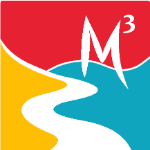
Moselle³-Trail au pays des trois frontières
Welcome to the M³-Trail within the borderless triangle German-French-Luxembourg
About
Presentation
Welcome to the M³-Trail within the borderless triangle. Discover on 33 kilometres the German-French-Luxembourg border region with its very special charm and its eventful history.
Tough years of war, countless border shifts, power struggles, negotiations and agreements have shaped the border region and its people for centuries. On closer inspection, the natural landscape with its trenches, overgrown anti-tank barriers, bomb craters and hidden bunkers still reveals the scars of those times. Thanks to the Schengen Agreement, the region has now grown together into a borderless, common living and cultural area. The M³-Trail offers the opportunity to find out more about the way the area works together in harmony through its culture, its people and its history.
Particularly exciting stops are the European Museum in Schengen, the Château des Ducs de Lorraine in Sierck les Bains and the Franco-German Peace Chapel near Perl.
Several starting points are possible: European museum Schengen (L), Wanderparkplatz Sehndorf (D), Bahnhof Perl (D), Maison de la Nature Montenach (F
Accommodation along the trail:
Youth Hostel Remerschen (L)
Hotel/Restaurant Maimühle, Perl (D)
Domaine de la Klauss, Montenach (F)
Did you know?
The Schengen Agreement
On June 14th, 1985 the "Schengen Agreement" was signed on the cruise boat" M.S. Princesse Marie-Astrid" on the Moselle River in Luxembourg. It is an agreement between France, Germany and the Benelux countries to abolish internal border controls between them. Since then, the name of this little wine village in Luxembourg, on the banks of the Moselle facing Perl in Germany is synonymous with a borderless Europe.
On June 19th, 1990, a second agreement (Schengen implementation Agreement) was signed at the same place, defining the concrete practical implementation of the agreement in legal and technical terms. The Treaty of Amsterdam, which came into force on May 1st, 1999, incorporated the Schengen acquis into European law. In the meantime, many other EU countries have joined the Schengen Agreement as well as the non-EU countries Iceland, Norway, Switzerland and Liechtenstein. Visas issued by a Schengen member state are valid in the entire "Schengen area".







